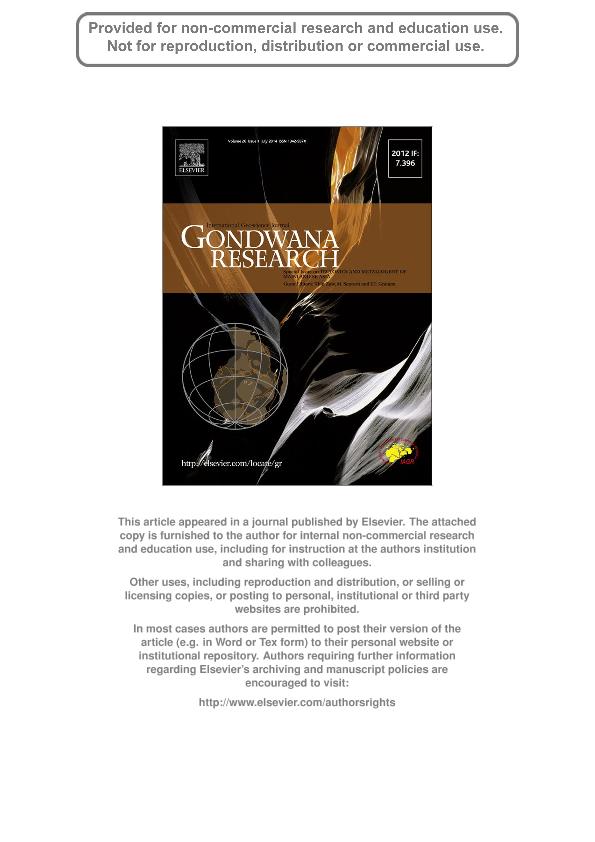Artículo
New constraints on the Jurassic–Cretaceous boundary in the High Andes using high-precision U-Pb data
Vennari, Verónica Vanesa ; Lescano, Marina Aurora
; Lescano, Marina Aurora ; Naipauer, Maximiliano
; Naipauer, Maximiliano ; Aguirre-Urreta, Maria Beatriz
; Aguirre-Urreta, Maria Beatriz ; Concheyro, Graciela
; Concheyro, Graciela ; Schaltegger, Urs; Armstrong, Richard; Pimentel, Marcio; Ramos, Victor Alberto
; Schaltegger, Urs; Armstrong, Richard; Pimentel, Marcio; Ramos, Victor Alberto
 ; Lescano, Marina Aurora
; Lescano, Marina Aurora ; Naipauer, Maximiliano
; Naipauer, Maximiliano ; Aguirre-Urreta, Maria Beatriz
; Aguirre-Urreta, Maria Beatriz ; Concheyro, Graciela
; Concheyro, Graciela ; Schaltegger, Urs; Armstrong, Richard; Pimentel, Marcio; Ramos, Victor Alberto
; Schaltegger, Urs; Armstrong, Richard; Pimentel, Marcio; Ramos, Victor Alberto
Fecha de publicación:
07/2013
Editorial:
Elsevier Science
Revista:
Gondwana Research
ISSN:
1342-937X
Idioma:
Inglés
Tipo de recurso:
Artículo publicado
Clasificación temática:
Resumen
The Jurassic–Cretaceous (J–K) boundary is poorly constrained, and is the only Phanerozoic system boundary that lacks an internationally accepted reference stratigraphic section (GSSP). Precise radio-isotopic U–Pb data are unavailable for the earliest stage of the Cretaceous— the Berriasian. The age of the Jurassic–Cretaceous boundary was based on several assumptions, including the relative duration of ammonite zones, the constant spreading rates of magnetic anomalies, and the extrapolation of Rb–Sr or K–Ar isotopic data. This paper discusses a site in an Andean Basin of Western Gondwana showing the J–K boundary interval with geographically widespread nannofossil markers which are here uniquely combined with precise radiometric dates. The recent finding of a sequence of marine black shales in the High Andes of Argentina, interbedded with ash-fall tuffs, provides important constraints on this boundary. This succession bears calcareous nannofossils and ammonites, which allow correlation with well-established Tethyan floras and faunas in the northern hemisphere. The Tithonian–Berriasian transition in the Andes was recognized on the basis of ammonite zones and nannofossil bioevents for the first time in the southern hemisphere. The new ages obtained are 137.9 ± 0.9 Ma by sensitive high-resolution ion microprobe (SHRIMP), and 139.55 ± 0.09/0.18 Ma by chemical-abrasion isotope-dilution thermal ionization mass spectrometry (TIMS) near the base of the Berriasian. These new ages can be interpreted in two different ways. The first alternative would indicate that the present geological time table is correct and the fossil levels should be late Berriasian. The second alternative is that the J–K boundary is 5 Ma younger than the recently published geological time scale. The authors support the last alternative and propose that the J–K boundary should be close to 140 Ma.
Palabras clave:
Neuquen Basin
,
Geocronologia
,
Paleontologia
,
U-Pb
Archivos asociados
Licencia
Identificadores
Colecciones
Articulos(IDEAN)
Articulos de INSTITUTO DE ESTUDIOS ANDINOS "DON PABLO GROEBER"
Articulos de INSTITUTO DE ESTUDIOS ANDINOS "DON PABLO GROEBER"
Citación
Ramos, Victor Alberto; Pimentel, Marcio; Armstrong, Richard; Schaltegger, Urs; Concheyro, Graciela; Aguirre-Urreta, Maria Beatriz; et al.; New constraints on the Jurassic–Cretaceous boundary in the High Andes using high-precision U-Pb data; Elsevier Science; Gondwana Research; 26; 1; 7-2013; 374-385
Compartir
Altmétricas



